
The expedition cruise to the Antarctica is an active and dynamic voyage, with the aim of landing as much as it is possible and making cruises with the ship through Canals and fjords to enjoy awesome landscapes and exotic fauna of the White Continent.
CRUCERO
A cruise to the Antarctica is the best option to explore this remote part of the planet as there is no hotels infrastructure on the continent for tourism. The ship will be your home during the trip.
DURATION
The duration of the voyages can vary from 6 to 30 days. There are different destinations within the Austral Ocean and different ships, from cruises to luxury yachts and more adventurous ships and small sail ships.
PROGRAMA EDUCATIVO
The educational program shall be carried out by polar expert teams who will give lectures and guide you during the land visits. There is a wide option of ships and trips to choose.
VUELO
You also have the option to fly through the Drake passage and joing the cruise already in the Antarctic. There are often additional activities which can be made as optional adventures, such as kayak, camping, and snow racquets.
ITINERARIES
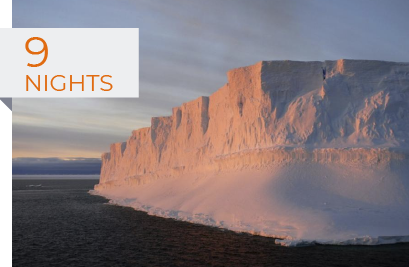
Antarctic Peninsula
Expedition cruise to the antarctic península and South Shetland islands. THe antarctic península has the most dramatic landscapes in the world. It is surrounded by glaciers and icebergs and you will have the opportunity to see penguins, seals and whales.
Duration: 9 nights, Boarding: Ushuaia, Landing: Ushuaia, Language: English
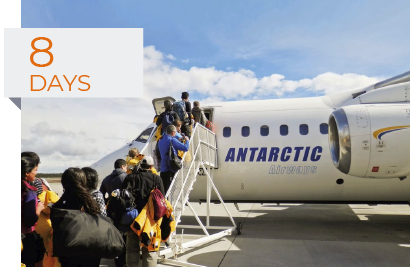
Express Antarctica - Flying the Drake
Just in 8 adventurous days you will be compensated with land visists and cruises on Zodiac boats. Feel marveled with the intimate encounters with wild life, explore the historical sites and take full advantage of the unforgettable visit to the 7th continent. Choose among the variety of adventures options and on board activities which coincide with your personal interests and make your expedition be exclusively yours.
Duration: 8 days, Boarding: Punta Arenas, Landing: Punta Arenas, Language: English
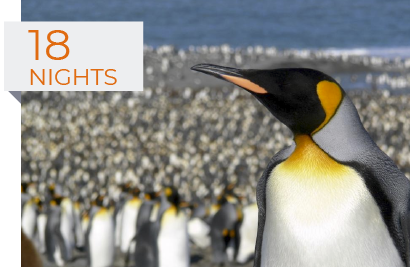
Malvinas, South Georgias and Antarctic Península
This is a voyage to Malvinas Islands, South Georgias and Antarctic Peninsula, where you will be able to see 7 species of penguins.
Duration: 18 nights, Boarding: Ushuaia, Landing: Ushuaia, Language: English
ITINERARIOS
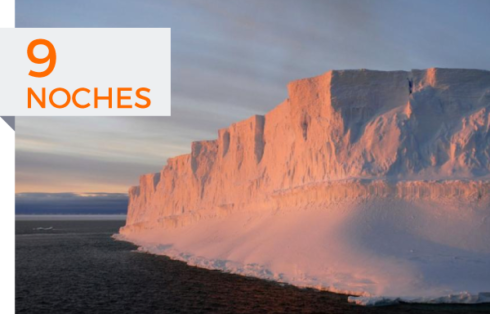
Península Antártica
Crucero de expedición a la Península antártica y las islas Shetland del Sur. La Península antártica posee uno de los paisajes más dramáticos del mundo. Estará rodeado de glaciares y témpanos y tendrá la oportunidad de ver pingüinos, focas y ballenas.
Duración: 9 noches, Embarque: Ushuaia, Desembarco: Ushuaia, Idioma: Inglés
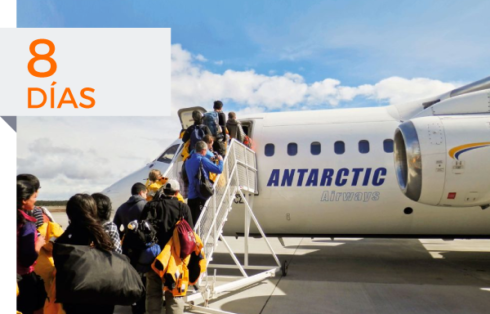
Antártida Express - Volando el Drake
En solo 8 días llenos de aventuras, será recompensado con visitas a tierra y cruceros en botes Zodiac. Maravíllese con los encuentros íntimos con la vida silvestre, explore sitios históricos y aproveche al máximo su inolvidable visita al 7º Continente. Seleccione entre una variedad de opciones de aventura y actividades a bordo que coincidan con sus intereses personales y haga que su expedición sea exclusivamente suya.
Duración: 8 días, Embarque: Punta Arenas, Desembarco: Punta Arenas, Idioma: Inglés
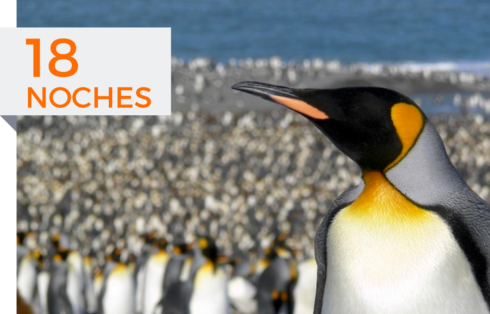
Malvinas, Georgias del Sur y Península Antártica
Este es un viaje a las islas Malvinas, Georgias del Sur y la Península Antártica, donde tendrá la oportunidad de ver potencialmente 7 especies de pingüinos.
Duración: 18 noches, Embarque: Ushuaia, Desembarco: Ushuaia, Idioma: Inglés
PREGUNTAS FRECUENTES
WHEN TO GO?
This is the time when the landscape looks more pristine as the continent is covered in snow from the top of the mountains to the coast. The Penguins arrive to the rookeries and start building their nests. It’s also the time with more chances to find sea ice when we are down south. This will give you the amazing opportunity to take in the sea ice environment: the pack ice and ice floes; with high chances to see seals resting on the ice; in the other hand it can also block many areas like channels, bays, and landing sites. During this period, penguins, shags and seabirds court and lay their eggs. Although there are always some opportunities to see whales, this is probably the time when we have less chances to see the giants of the sea, as they are still travelling from more temperate water where they breed to the Southern Ocean to feed.
At this time the snow starts to retreat, exposing rocky headlands and shorelines. The days are longer and there are 24hs of daylight. Early in December the penguins will still be busy laying eggs and tidying up the nests, by late December (depending on how much snow there was at the beginning of the season) or early January, penguin chicks hatch and start growing rapidly as their parents take turns feeding their young. Most whales are arriving and there are more chances to see them than at the beginning of the season. Sea ice starts to melt away and some channels will open up for navigation. However, due to the dynamics of the sea ice and the ocean currents, ice can block many places at any time of the year.
In the last part of the season, days will start getting shorter and shorter, but whales will come to feed. Seals haul out on the beach, adult penguins begin to moult, and chicks will start fledging. Adelie penguins will be the first ones to leave, followed by chinstrap penguins and the last ones to leave will be the Gentoo penguins. Antarctica is saying goodbye to the Southern summer. The highlights for travelers at the end of the season will be whales, red snow (snow algae) and fledging Gentoo Penguins.
¿WHAT TO WEAR?
The choice of clothing for cold climates is a very personal matter. It depends on your individual experience with cold conditions.
Are you more susceptible to cold temperatures than other people?
A common complaint is not the cold, it’s the wind, but an equally common polar maxim is there is no such thing as bad weather, only bad clothing! The secret to keeping warm is to dress in layers. It is better to have several light layers of clothing than one heavy layer. This also gives you flexibility in your clothing so you can take off a layer if you are too warm or put another layer on if you are cold. The most important layer is the outer waterproof and windproof shell because even a light wind of 6 kph (about 4 mph) can carry away eight times more body heat than still air! The so-called wind chill factor measures the increase in cooling power of moving air, whether it is wind that is blowing or it is you who is moving rapidly and, in effect, creating a wind against yourself.
We recommend dressing in layers so you can put on or take off clothing anytime you need it. Long thermal underwear, a thermal shirt and pants, and thermal socks are important. Bring a fleece or two (this is very personal) to put over the thermal layer. As per the outer layer, it is very important to bring waterproof clothing.
- Waterproof jacket (some ships provide this)
- Waterproof trousers
- Waterproof gloves or mittens (two pairs to rotate when wet would be ideal)
- Rubber boots
Pull-on, unlined, knee-high boots are required for wet landings. Boots must be 14″-16″ high with strong, rubber-ridge, non-skid soles. These specifications are very important. You may be stepping into water up to 10″ deep on wet landings. Moon or leather boots are NOT appropriate.
- Hat, scarf, or other face protection
- Fleece or sweaters
- Thermal socks (at least two pairs to rotate when wet)
- Warm pants
- Thermal or long underwear
- Lightweight shirts and T-shirts
- Comfortable and casual clothing to wear on board.
- Sunscreen and lip protection (It is recommended high protection)
- Sunglasses
- Binoculars
- Plastic zip-lock bags will protect your camera and binoculars from wave splash and spray while in Zodiacs
- Backpack (ideal to bring extra layer ashore, water, binos, camera, etc).
- Avoid overdressing to reduce perspiration.
- Wear water repellent outer garments that will keep you dry on the outside and still allow moisture from your body to escape.
- Body heat is most likely to be lost from parts that have a lot of surface area in comparison to total mass – namely, the hands and feet. Keep them warmand dry. For hands, mittens are better than gloves.
- If you have cold feet, put a hat on. If the rest of your body is covered, as much as 90 percent of the heat you lose can come from your head, so be sure to wear a cap, beanie or balaclava. These items can be pulled down to protect your ears, forehead, neck and chin. The neck also needs protection with a woollen or synthetic scarf, which can be wrapped around the face when travelling against the wind.
- Dress in comfortable, loose layers. For anyone out in the cold, it is far better to wear layers of relatively light, loose clothing than one thick, heavy item. Between each layer there is a film of trapped air which, when heated by your body, acts as an excellent insulator.
- Wool and silk are superior to cotton because they can trap warm air. Synthetic fabrics that spring back into shape after compression are also good.
- When damp or wet, polyester down is a better insulator than goose or duck down. Polar fleece is popular and recommended.
ABOUT SEBASTIÁN
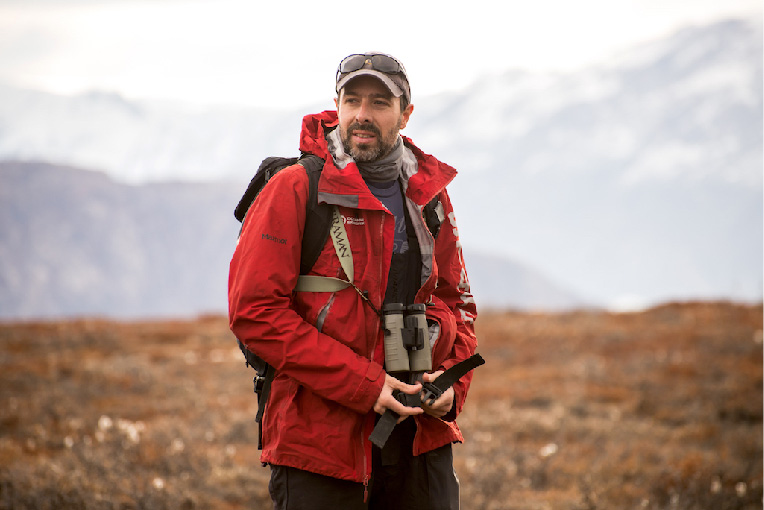
Sebastian has over 15 years of experience traveling to Polar Regions. He has led more than one hundred trips to Antarctica onboard different vessels, lecturing on Geography, Ice, and Antarctic History. Since 2008, he extended his polar experience to the Arctic, sailing in the Canadian Arctic, part of the Northwest Passage, Greenland and Svalbard.
As a lecturer on Antarctic topics, he has been invited to the annual meeting of the International Superyacht Society, in Fort Lauderdale, Unites States, and to the Antarctic week organized annually in Ushuaia, Argentina, the southernmost city in the world. He has written several articles related to Antarctica in different magazines and publications, like The Great Southern Route, Superyacht Times, and Boat International among others.
He is co-author of the complete book about Antarctica “ANTARCTICA, DISCOVERING THE LAST CONTINENT”.
Sebastian is also co-founder of FUNDACIÓN PARA LA CONSERVACIÓN DEL PATRIMONIO ANTÁRTICO, an NGO devoted to the conservation of the Antarctic Heritage.
